Facts About Pumpkin
Pumpkins are a type of winter squash that are typically round, smooth-skinned, and commonly orange. They belong to the genus Cucurbita, with the most prevalent species being Cucurbita pepo. Native to North America, pumpkins have been cultivated for thousands of years, dating back to between 7,500 and 5,000 BC. Today, they are grown for various purposes, including commercial use, culinary applications, decoration, and recreational activities.
The name "pumpkin" derives from the Greek word "pepon" meaning "large melon." Notably, there is no strict botanical definition for pumpkins, and the term is often used interchangeably with "squash" and "winter squash." The vibrant orange color of pumpkins is attributed to carotenoid pigments.
Pumpkins are cultivated worldwide, with the exception of Antarctica. In the United States, Illinois stands out as a major hub for pumpkin production and processing. For optimal growth, pumpkins require warm temperatures and effective pollination.
Nutritionally, pumpkins are commendable due to their low calorie content and high levels of provitamin A, vitamin C, and other essential nutrients. They are remarkably versatile in culinary applications and are incorporated into a wide array of dishes globally, from soups and pies to snacks and desserts. Pumpkin seeds, also known as pepitas, are not only delicious but also rich in nutritional value.
Beyond their culinary uses, pumpkins have a history in folk medicine for treating various ailments. Pumpkin seed oil is favored both in cooking and as a dietary supplement. Culturally, pumpkins hold significant importance, especially during Halloween when they are carved into jack-o'-lanterns. Numerous festivals, competitions, and stories celebrate pumpkins, underscoring their cultural significance.

 Canada
Canada